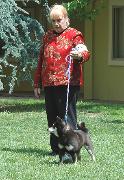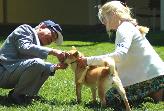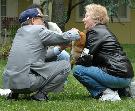A Nippo-Style Show

The ring is separated into two sections - one section for dogs and one for bitches.
Dogs are first evaluated individually, with all dogs completed before bitches. The judge completes a Nippo form to aid him in evaluation.
Dogs are judged by the NIPPO standard for each breed.
Full dentition is the standard. NO ALLOWANCES WILL BE MADE FOR MISSING TEETH. 'WEAK' or undersized teeth are considered similar to missing teeth.
The handler stands behind the dog with the leash on the lower part of the dog’s neck, pulling gently at a 45-degree angle.
No baiting or double-handling is allowed.
The dog should stand naturally and face the judge boldly, standing naturally firm.
Showing the dog on too tight a lead will create wrinkles on the face and head and cause the ears to drop.

All dogs are judged on the ground,

except young dogs may be picked up to facilitate teeth check.
Misbehavior during teeth counting is not held against the dog. (counting teeth may be done by the Nippo judge, or by the AKC assistant)
Misbehavior during teeth counting is not held against the dog. (counting teeth may be done by the Nippo judge, or by the AKC assistant)
Typically, the judge faces the dog in a squatting position, making notes on a critique sheet. During the individual judging the teeth are counted and dentition noted. All dogs in regular classes are wicketed, however there is no disqualification for an exhibit under or over the standard height. The wicket is not the same as an AKC wicket. Dogs will stand on a flat hard surface for measuring. Wicketing may be done by the Nippo judge or the AKC assistant. As each dog is examined, the judge completes a NIPPO standard evaluation form. These forms are NOT provided to exhibitors, but the judge refers to them during post-show individual critiques.
The judge may chose to move each dog to evaluate movement and attitude. The pattern is typically a triangle.
During the lunch break, the judge reviews his evaluation forms and notes in preparation for comparative judging.
The judge may chose to move each dog to evaluate movement and attitude. The pattern is typically a triangle.
During the lunch break, the judge reviews his evaluation forms and notes in preparation for comparative judging.
Comparative Judging Phase
Sometimes a little video is useful

Dogs may be gaited individually or in groups. The judge may rearrange the order of dogs, but that does not always signal order of preference.
Class placements are made with the 4th place dog selected first, and the winner of the class announced last.
Dogs placing in the classes receive points toward their Nippo/USA championship and may receive additional recognition from Nippo.
The winner of each class competes for the Best Dog and Best Bitch in that Breed. Best Dog and Best Bitch compete for Saikosho (Best of Breed) and Jun Saikosho (Best of Opposite Sex). At the discretion of the judge, if there are sufficient number of quality exhibits in an individual breed (usually 5 or more quality exhibits) the Saikosho and Jun Saikosho of that breed may be awarded Nippo/USA Championships.
Saikosho of each breed will compete for the Classic Supreme and Reserve Supreme awards. (available only when competition is between two or more breeds)
All competitors may confer with the judge individually after the event for verbal critique and evaluation, however the judge does not provide written forms to exhibitors.
Class placements are made with the 4th place dog selected first, and the winner of the class announced last.
Dogs placing in the classes receive points toward their Nippo/USA championship and may receive additional recognition from Nippo.
The winner of each class competes for the Best Dog and Best Bitch in that Breed. Best Dog and Best Bitch compete for Saikosho (Best of Breed) and Jun Saikosho (Best of Opposite Sex). At the discretion of the judge, if there are sufficient number of quality exhibits in an individual breed (usually 5 or more quality exhibits) the Saikosho and Jun Saikosho of that breed may be awarded Nippo/USA Championships.
Saikosho of each breed will compete for the Classic Supreme and Reserve Supreme awards. (available only when competition is between two or more breeds)
All competitors may confer with the judge individually after the event for verbal critique and evaluation, however the judge does not provide written forms to exhibitors.